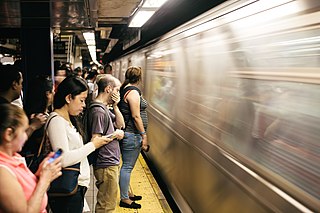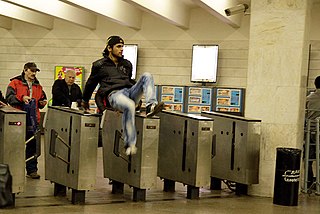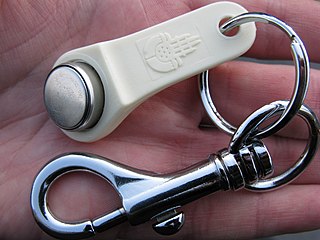
The Massachusetts Bay Transportation Authority is the public agency responsible for operating most public transportation services in Greater Boston, Massachusetts. The MBTA transit network includes the MBTA subway with three metro lines, two light rail lines, and a five-line bus rapid transit system ; MBTA bus local and express service; the twelve-line MBTA Commuter Rail system, and several ferry routes. In 2023, the system had a ridership of 239,981,700, or about 796,300 per weekday as of the second quarter of 2024, of which the rapid transit lines averaged 265,900 and the light rail lines 95,900, making it the fourth-busiest rapid transit system and the third-busiest light rail system in the United States. As of the second quarter of 2024, average weekday ridership of the commuter rail system was 107,500, making it the fifth-busiest commuter rail system in the U.S.

The Long Island Rail Road, or LIRR, is a railroad in the southeastern part of the U.S. state of New York, stretching from Manhattan to the eastern tip of Suffolk County on Long Island. The railroad currently operates a public commuter rail service, with its freight operations contracted to the New York and Atlantic Railway. With an average weekday ridership of 354,800 passengers in 2016, it is the busiest commuter railroad in North America. It is also one of the world's few commuter systems that runs 24/7 year-round. It is publicly owned by the Metropolitan Transportation Authority, which refers to it as MTA Long Island Rail Road. In 2023, the system had a ridership of 75,186,900, or about 276,800 per weekday as of the second quarter of 2024.
A ferry is a boat that transports passengers, and occasionally vehicles and cargo, across a body of water. A small passenger ferry with multiple stops, like those in Venice, Italy, is sometimes referred to as a water taxi or water bus.

The Metro-North Commuter Railroad Company, also branded as MTA Metro-North Railroad and commonly called simply Metro-North, is a suburban commuter rail service operated by the Metropolitan Transportation Authority (MTA), a public authority of the U.S. state of New York. Metro-North serves the New York Metropolitan Area, running service between New York City and its northern suburbs in New York and Connecticut, including Port Jervis, Spring Valley, Poughkeepsie, Yonkers, New Rochelle, Mount Vernon, White Plains, Southeast and Wassaic in New York and Stamford, New Canaan, Danbury, Bridgeport, Waterbury, and New Haven in Connecticut. Service in Connecticut is operated under contract with the Connecticut Department of Transportation. Metro-North also provides local rail service within the New York City boroughs of Manhattan and the Bronx.

A rush hour or peak hour is a part of the day during which traffic congestion on roads and crowding on public transport is at its highest. Normally, this happens twice every weekday: once in the morning and once in the afternoon or evening, the times during which most people commute. The term is often used for a period of peak congestion that may last for more than one hour.

Shun Tak–China Travel Ship Management Limited, doing business as TurboJET, is a ferry company based in Hong Kong. The company was established from the joint venture between Shun Tak Holdings and China Travel International Investment Hong Kong in July 1999. It operates hydrofoil and high-speed ferry services between Hong Kong, Macau, Shenzhen, and Zhuhai in the Pearl River Delta area.

Intermodal passenger transport, also called mixed-mode commuting, involves using two or more modes of transportation in a journey. Mixed-mode commuting is often used to combine the strengths of various transportation options. A major goal of modern intermodal passenger transport is to reduce dependence on the automobile as the major mode of ground transportation and increase use of public transport. To assist the traveller, various intermodal journey planners such as Rome2rio and Google Transit have been devised to help travellers plan and schedule their journey.

Public transport in Istanbul comprises a bus network, various rail systems, funiculars, and maritime services to serve the more than 15 million inhabitants of the city spread over an area of 5,712 km2.
Auto Express 86 is a class of high-speed catamaran vehicle-passenger ferries built by Austal of Australia.

Passenger rail transport is one of the principal means of transport in the People's Republic of China, with rail passenger traffic exceeding 1.86 billion railway trips in 2011. It is operated by the China Railway Corporation (CR). The Spring Festival Travel Season is the peak railway travel season of the year.

The Istanbul Metro is a rapid transit railway network that serves the city of Istanbul, Turkey. Apart from the M11 line, which is operated by TCDD Taşımacılık, the system is operated by Metro Istanbul, a public enterprise controlled by the Istanbul Metropolitan Municipality. The oldest section of the metro is the M1 line, which opened on 3 September, 1989. As of 2024, the system now includes 159 stations in service, with 36 more under construction. With 243.3 kilometers, Istanbul has the 21st longest metro line in the world and the 5th in Europe.
Fred. Olsen Express is an inter-island ferry service based in the Canary Islands, Spain. It operates a fleet of six modern fast ferries on five routes. Its fleet includes a trimaran fast ferry, the Benchijigua Express, which was the first such vehicle in the world when it entered service in 2005. The company is owned by the Olsen family-controlled Bonheur and Ganger Rolf, which among other things also owns the shipping companies Fred. Olsen Cruise Lines and First Olsen Tankers.

Fare evasion or fare dodging is the act of travel without payment on public transit. When considered problematic, it is mitigated by revenue protection officers and ticket barriers, staffed or automatic, are in place to ensure only those with valid tickets may access the transport. The term fare avoidance is sometimes used as a euphemistic synonym and sometimes used to refer to the lawful use of much cheaper tickets.

Line M1, officially referred to as the M1 Yenikapı–Atatürk Airport/Kirazlı metro line, also known as the Istanbul Light Metro, is a rapid transit line of the Istanbul Metro. It is colored red on the maps and route signs. Opened in 1989, it was the first rapid transit line in Istanbul and Turkey and its opening started the revival of mass-transit in Turkish cities.

The State Railways of the Republic of Turkey, abbreviated as TCDD, is a government-owned national railway company responsible for the ownership and maintenance of railways in Turkey, as well as the planning and construction of new lines. TCDD was formed on 4 June 1929 as part of the nationalisation of railways in Turkey.

Akbil was an integrated electronic ticket system used for fare payment on public transport in Istanbul, Turkey, and was first issued in 1995. In 2009 it was replaced by the Istanbulkart; while existing Akbil tickets could still be used, new ones were no longer sold, and it was completely phased out 2015. It was valid for boarding buses, funiculars, LRT, metro, commuter trains, ferryboats and trams operated by the Metropolitan Municipality. Unlike payment by cash, the Akbil allowed a passenger to transfer service within the transportation network under some defined conditions. Akbil is a portmanteau formed from "akıllı", which stands for "smart", and "bilet" meaning "ticket".

Ferries in Istanbul are a mode of public transportation within and surrounding the city of Istanbul, Turkey. There are three major ferry operators in the city: the municipally owned Şehir Hatları, which operates traditional vapurs; the privately operated İstanbul Deniz Otobüsleri (İDO), which operates high-speed urban and intercity services, and the privately owned Turyol which operates mostly urban services.
The Yenikapı Ferry Terminal or Yenikapı Pier is a ferry terminal in Fatih, Istanbul, located along Kennedy Avenue on the Marmara Sea. It is used by İDO as a hub and is the largest ferry terminal in Istanbul. İDO operates several ferry routes from Yenikapı to destinations within Istanbul as well as across the Marmara Sea.

Turyol is a private ferry operator which owns and operates an urban and international ferry service in western Turkey, primarily around Istanbul. It is one of three private ferry operators in Istanbul, along with İDO and Dentur. Turyol maintains a fleet of 70 vessels, 60 of which are for scheduled passenger service. In terms of fleet size and the number of lines, Turyol is the largest private ferry operator in Turkey and second-largest overall, after the Istanbul Municipality's ferry operator, Şehir Hatları.




















